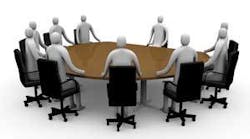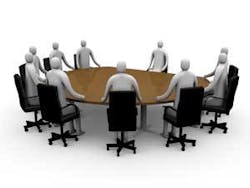Dentists and their staff members are busy. Busy taking care of patients, sterilizing instruments, scheduling appointments, managing overhead, calling the lab - the list is endless. It’s a lot of work and, at times, can feel like “to what end?”
That’s where staff meetings and huddles come in. Staff meetings and huddles provide the environment for communication among staff members that leads to more effective and creative problem-solving. Without regular staff meetings, dentists and their teams are doomed to spend countless hours working “in” their practices, but never really “on” them.
If you’re thinking, “We’ve had meetings before and they were a waste of time,” or “Our meetings tend to be gripe sessions,” or “I can’t afford to take away from patient hours,” the information in this article will surprise you. The time commitment is minimal and the process is straightforward and easy to implement.
To begin, choose which of the following statements best applies to your current situation: We hold regular staff meetings. Everyone loves them!We hold regular staff meetings. Everyone hates them! We hold regular staff meetings. Some are productive, some are a waste of time. We stopped holding staff meetings because they weren’t productive. We’ve never held regular staff meetings.Consider the statement you chose as your “starting point.” If you’re a 1, congratulations, you’re doing great! If you fall in the 2 through 5 range, there’s help for you here. Make the commitment to change the “status quo” in your practice and begin to see measurable, attainable, and stress-reducing results.Staff meeting objectivesGood staff meetings share these common objectives: Share information with the entire staff. When everyone is informed about practice goals and objectives, your chances of achieving those goals are improved. This also helps minimize the common complaint, “No one ever told me.”Establish goals and organize an action plan to set those goals in motion. Goals may include taking control of overhead, adding a new staff member, buying a new piece of equipment, or planning a new facility. The list is endless!Implement a system for problem-solving. Resolving practice issues quickly is key to long-term success and profitability.Ensure adequate follow-up to achieve results. Make accountability checks a part of every staff meeting.Practice honing new skills, or working on those that need refinement.Give respectful, encouraging, and supportive feedback.Recognize progress and inspire each other to commit to never-ending improvement. This is what builds a championship team!Confront challenging issues that are appropriate to address in a group setting. Focus on “bad behavior,” not “bad people.”Get to know each other better. The result is stronger and more trusting relationships.Achieving these objectives is possible with one decision - a commitment to hold weekly staff meetings. Once that decision is made, make sure your expectations are realistic, i.e., don’t expect giant leaps every week. Expect small, continuous improvements - and the occasional giant leap! Small steps will lead to amazing results in the course of one year.Whether you’ve had meetings in the past or will be implementing them for the first time, plan on achieving improved communication, exciting results, and the satisfaction of knowing you are investing in one of your most important assets - your practice!Roles and responsibilitiesYou’ve probably heard the complaints or uttered them personally: “Nothing was ever prepared for our meetings so we stopped having them.” The doctor says, “I don’t have the time to do the homework that’s required for meetings.” The staff says, “Our meetings are frustrating. A couple of people monopolize them.” To positively combat these common complaints, set the expectation that everyone has an important role in the meeting and a stake in the outcome. Make sure every staff meeting has a Facilitator, a Recorder, and, of course, Participants.The FacilitatorPicture a ringmaster at the circus. The ringmaster orchestrates each event by pointing at each ring at the right moment to signal that it’s time to perform. Without the ringmaster’s ability to take control and organize the performance, chaos is guaranteed!The Facilitator is the “ringmaster” of the meeting - not the “performer,” but the person who ensures a successful outcome.Prior to the meeting (one or two days):1) Check the agenda. A good agenda will include the following information:
- Date
- Type of meeting, i.e., training, numbers, teamwork
- The time the meeting starts
- The time the meeting ends
- The name of the Facilitator
- The name of the Recorder
- Agenda topics, with the estimated time each topic will take
- Any pre-preparation needed by participants, i.e., “Watch video on payment negotiation skills.”
- Generate ideas for additional agenda topics.
- Determine what topic(s) must be postponed to a future meeting if the agenda has more topics than it can accommodate in the time allowed.
- Engage totally. Pay close attention to all discussions. Avoid side discussions.
- Participate by offering ideas, support, and solutions.
- Voice concerns or objections respectfully, with the reason for the concern.
- Ask for clarification if something is unclear or not understood.
- Commit to understanding other’s points of view - even when it is different from yours or the group’s. Don’t expect total agreement. Differences of opinion often lead to the most creative and productive solutions.
- Expect to collaborate and enhance consensus-building skills.
Consider this: If participation is limited, get to the root cause. Ask yourself the following questions:
- When ideas are expressed, are the ideas ridiculed?
- Do you allow “stronger” personalities to control the meeting?
- Are you afraid that if you encourage someone to participate, you will embarrass or offend them?
Doctor responsibilities
As with other staff members, the doctor also has a role to play in ensuring a successful meeting. This includes:
Before the meeting:Review the agenda.Respect the time set aside for meetings - do not schedule anything else during meeting time.Follow through with suggested pre-meeting preparation.Assist the Facilitator with organizing the agenda.During the meeting:- Be on time.
- Support the Facilitator (if necessary, help him or her manage the meeting).
- Be an active listener. Encourage staff by asking for their opinions, and for clarifications of their statements, if necessary.
- Resist the temptation to give quick solutions. Instead, try to draw them out of the staff.
- Foster a climate of acceptance and respect.
- Exhibit positive body language.
- Take notes.
- Expect commitment from the entire team, and follow through with action plans.
- Follow-up on action plans. Expect the staff to report the status of action plans to you.
- Take action for the tasks for which you agreed to be responsible.
- Be available to the staff in a supportive capacity, or as a resource for their questions or advice.
Staff responsibilities
Remember, everyone has an important role to play. This includes:
Before the meeting:- Review the agenda the day before the meeting
- Respect the time set aside for meetings - do not schedule anything else during meeting time.
- Confirm the roles of Facilitator, Recorder, and Participants.
- Assist with the preparation of the staff meeting room, including seating arrangements, refreshments, etc.
- Follow through with suggested pre-meeting preparation.
- Be on time. Note to the Facilitator: if any participant is late for an avoidable reason, begin the meeting without him or her.
- Follow the agenda.
- Listen, respect other participants’ input, and participate.
- Focus on solutions and expect to collaborate.
- Avoid side conversations.
- Use positive body language.
- Take notes.
- Avoid distracting behavior.
Tools for success
You can increase the efficiency of your next staff meeting by using these simple “tools.” We’ve referred to them briefly above, now let’s look at them in more detail.
The agenda
Productive staff meetings are the result of planning and organization. A well-prepared agenda (that is followed during the meeting) helps eliminate that well-known complaint - “Our meetings are a waste of time!”
Benefits:- A well-organized agenda helps direct the meeting, identifies the roles of the participants, and lists how much time is needed for each topic.
- Topics are defined, which enables staff to be prepared for the meeting.
- Preparation doesn’t fall on just one person’s shoulders - everyone is involved in preparing the agenda.
- Action items are listed in an organized manner.
- Assignments are specifically spelled out.
- Assignments are easily managed by posting the action plan in a central area.
Other helpful staff meeting tools
Flipchart and easel - A flipchart serves as a place to organize ideas and also as a common focal point. Use it during brainstorming sessions, and also as the place to document preliminary action plan items. (Note to Facilitator: Prior to the meeting, always check, or delegate someone else to check, to make sure you’re not down to the last sheet of flipchart paper.)
Thick flipchart markers - Avoid using yellow, orange, and red. They are difficult to read on the flipchart. Black or dark blue is best.Bulletin board - Hang the bulletin board in a central staff location. Post agendas, current action plans, memos, notices, motivational quotes, etc.Meeting adjourned
There it is. You now have the simple tools and rules you need to plan, conduct and benefit from weekly staff meetings. Commit to just one hour per week and see what amazing results can occur in your practice. Get started today.”Virginia Moore and Debbie Castagna's experience and expertise range from work in private practice to founding their total practice resource company, The Practice Source. They are speakers, consultants, and co-authors of management resource guides, "The Doctor as CEO" and "The Ultimate Staff". Moore and Castagna can be contacted at [email protected] or [email protected]. You can also visit www.thepracticesource.com







